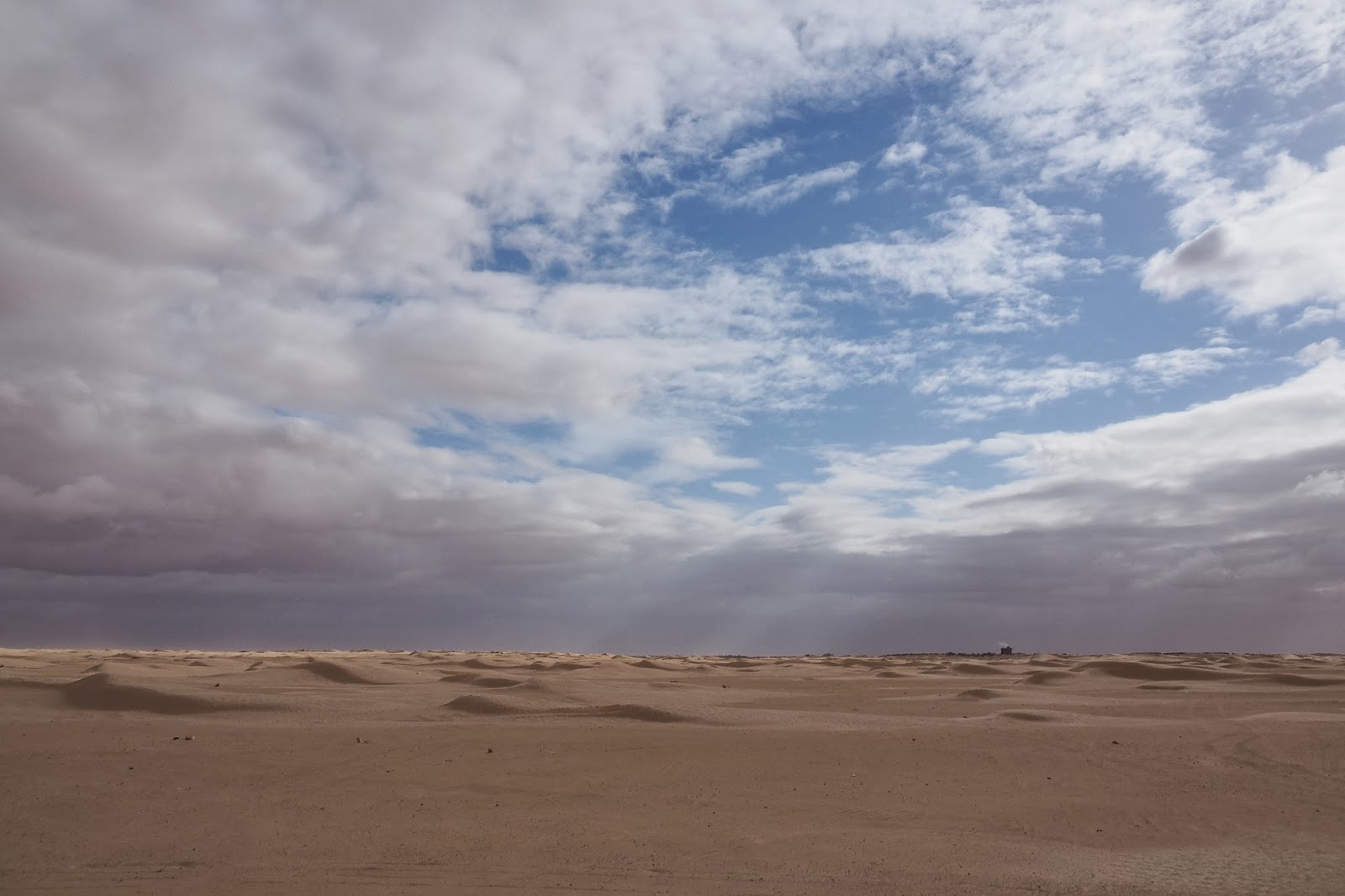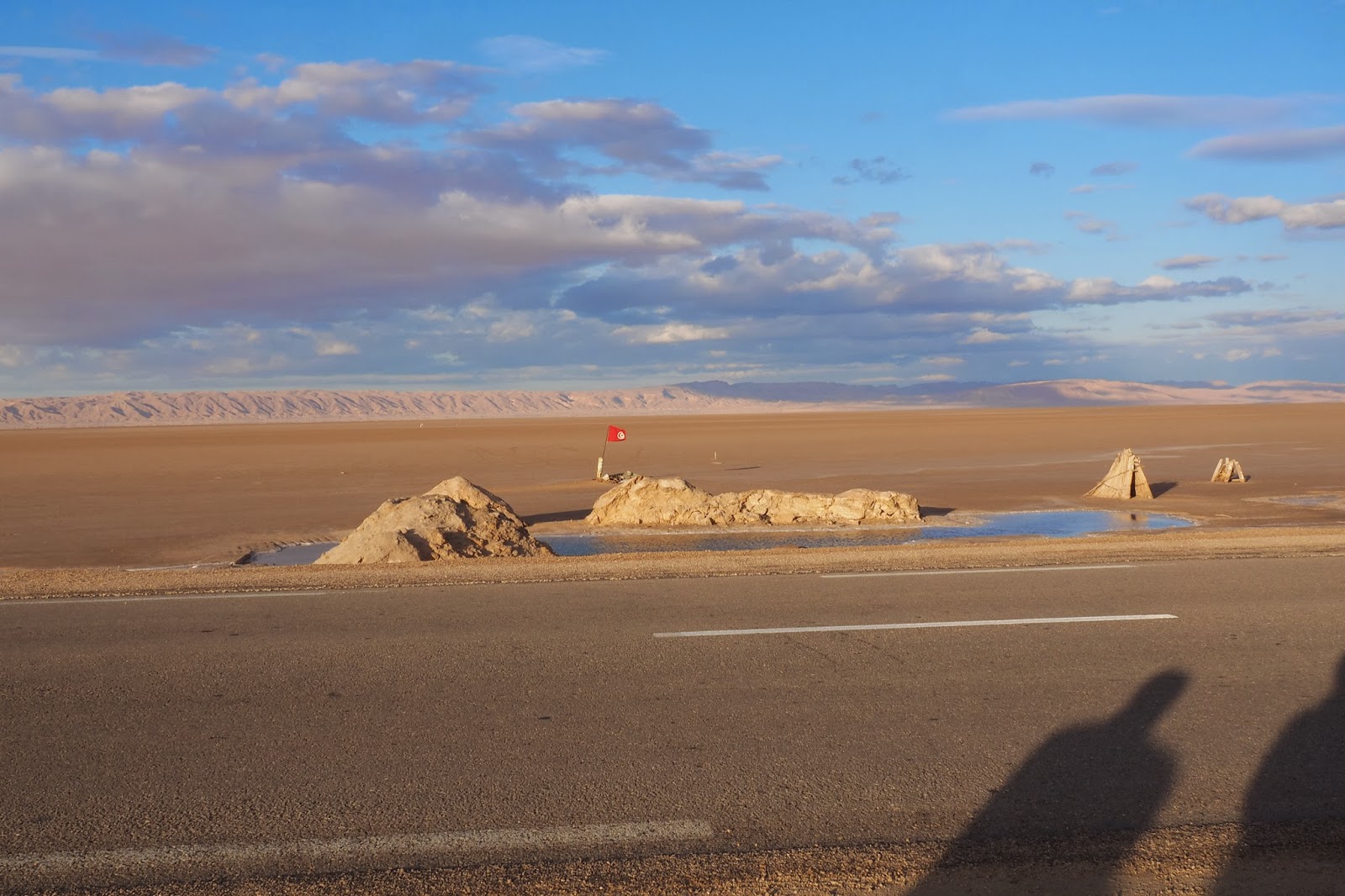After seeing how some Berber people live in underground caves, we were given a taste of the Sahara, nearly 300 miles south of Tunis, in the suburbs of a small town called Douz, and about 1.5 hour coach journey away from Matmata. Douz has been called the "gateway to the Sahara" because in the olden days, it was an important stop for the trans-Sahara caravan routes. Even now, a 4-day International Festival of the Sahara would be held in November or December each year when there would be camel wrestling, horse races, salugis ( a game in which a player would snatch a ball from another and then keep on passing it to a third and the third and the fourth etc would do the same), music and dancing and the traditional caravan market days are still continuing. Douz has also been called "the ultimate palm oasis" because there are more than 500,000 palm trees there.
This is where we would have our camel ride.
For those who fancy doing so, there's even a coach ride
Though it's desert, there are some trees where there's some underground water.
The weather didn't look good
But from time to time, the sun would emerge from the clouds to dispel fears that our camel ride may have to be canceled because of rains.
After changing into Arab robes and turban, we're on our way
The camels are well trained: they merely follow one after another.
Some saddles on the single-hump camels are mounted much higher than on others.
Mine is more or less in the same position as the one shown here
The line of camels is led by a camel boy
A fully dressed Berber horseman is beckoning us and asking if anyone would like to share a ride with him. One of our tour members could not resist the temptation.
There's our tour member with the horseman
The sand dunes at the start of the Sahara
We're lucky. When the camel ride began, the sky started to clear a little
Ever seen a camel's tongue before? Boy, that's pulpy and long !
The white camel seemed to like the little boy and kept licking his face.
Looking back at where we started from the back of my camel
A break in the clouds above a break in the line of trees
At the end of the ride, the camels are being led back to their resting place
Light and shadows at the camel station
A handsome Berber youth
But he says he prefers to have his picture taken with his mouth covered.
The Berber camelmen: the younger in jeans and fleece T-shirts, the older in their "barnous".

The entrance/exit of the camel station
Some Tunisian looking shirts and some modern T-shirts
A statue on our way into the town of Douz
A video of the Festival of the Sahara from U-tube
A very Arabian looking small hotel our coach passed.
The sky appears to be clearing more
Another hotel we passed
Another sculpture
A pennant? A staircase to a better future? or to the Islamic heaven?
A market we passed
On both sides of the road, we find endless desert where little grows
a hovel by the side of one of the famous "salt lakes" of Tunisia we passed by.
According to the Wikipedia, there's a series of such salt lakes south of the Atlas Mountains at the northern edge of the Sahara including from east to west, the Chott el Fedjedji, Chott el Djerid, and Chott el Gharsa, more than 20 miles.They are peculiar in that stretch with only two short breaks in a line from the Mediterranean at the Gulf of Gabès to the Algerian frontier into which they penetrate. The French term "chott" is a transliteration of the Arabic "shat", a term for a broad canal, an estuary or lake but such "shats" are, strictly speaking, not "lakes" at all, just smooth depressed areas which for more than half the year are expanses of dried mud covered with a thick incrustation of white or grey salt which gives them the "appearance" of big sheets of water. On the rare occasions when there's really heavy winter rainfall, there may actually be 3 or 4 ft. of water in such "shats" which makes them perfectly impassable. For for about seven months of the year they can be crossed on foot or on horseback. But for a very long time in the past the freshwater streams which used to predominate here have been drained for irrigation purposes to such a degree that now very little of the precious water is allowed to run to waste into the lake basins so such basins get only a few salt streams, which deposit on their surface the salt they contain and then evaporate. It's this water supply of fresh warm water maintains oases of extraordinary luxuriance in a country where rain falls very rarely.
An example of such salt deposit
Another view of the salt puddle
The same puddle from the opposite angle
Another such puddle on the other side of the road
The road runs straight on, for miles and miles and miles, with little or nothing on each side
We were practically in the middle of nowhere
How small is our coach and how high the sky
There is nothing but the salt flats below and clouds in the sky above
The salt "lake" was little but a stretch of dried up stream
We were practically in the middle of nowhere
How small is our coach and how high the sky
There is nothing but the salt flats below and clouds in the sky above
The salt "lake" was little but a stretch of dried up stream
A row of sheds catering for the needs of curious tourists
More of such "shats" taken from the coach window
One can see how the water runs into the puddles
Another one. There are so many of them that after a while they ceased to attract my attention.
As far as the eye can see, little but the hardiest and very small plants would grow
We are nearing the outskirts of the little town of Tozeur, an oasis town
The closer we get to Tozeur, the more vegetation
Finally a market and some saliva-inducing roast chicken at a small food stall at the side of the road in the little town.
A local vegetable and fruit market
I picked some oranges: they're good, sweet and full of "orange flavor" and some bananas which taste like bananas
tomatoes, lentils and oranges
nor these huge pumpkins
nor the little red onions, cauliflower, potatoes, cabbages, the usual stuff on Tunisian dinner tables
No matter where you go, you will always find such square minarets
Our hotel lobby
Its walls are decorated with these sculptures
The lift lobby of our floor
a nice painting on the wall
Pitchers under the stair hood
A closer view
I like its reflections: the Arabs are famous for their use of reflection upon the surface of water
More reflections
The pavilion opposite to our waiting coach the following morning
Whilst waiting for the late comers, I looked around
And took some picture of the leaves in the morning sun
and a flower or two
and even this little growing at the bottom of a wall. We're told we'd be going to Tozeur.
To be cont'd










































































沒有留言:
張貼留言